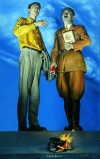
Illustration:
ill. 5.18 a (set: 5.17)
Author:
Liu Chunhua (1944-) 刘春华
Date:
1967
Genre:
painting, oil painting
Material:
scan, paper, colour; original source: oil painting, colour 106 x 76 cm.
Source:
Liu Chunhua Mao goes to Anyuan, 1967 (http://chineseposters.net), Heidelberg catalogue entry
Courtesy:
IISH Stefan R. Landsberger Collection
HeidICON Image ID:
52152
Keywords:
Mao Zedong, Anyuan, Mao goes to Anyuan, model work, model image, model portrait, Mao´s portrait, Mao portrait, Cultural revolution, mountains, chinese landscape, rising sun, Mao Zedong Thought, proletarian revolutionary line, icon, Revolutionary Realism
Liu Chunhua: Chairman Mao goes to Anyuan (Liu Chunhua: Mao Zhuxi qu Anyuan 刘春华: 毛主席去安源)
Structurally, the two works are very similar in design: they both present Mao as an overpowering figure on top of a mountain with clouds and mountain peaks in the background echoing Mao’s movements. Yet, in the case of Jin, who depicts the older Mao in a Mao suit, the European model is much more obvious, his mountains are much less rugged, cone-shaped and sharp, they are much more flat, rolling and smooth and thus far less akin to the Chinese tradition of painting mountain ranges (ill. 5.18). By adding iconographic elements from Chinese landscape painting into an oil composition in the style of Revolutionary Realism and Revolutionary Romanticism, Liu, on the other hand, had created a perfect piece of national flavour, combining the best of European art (no matter from what period, any European art would be considered “contemporary” or “modern” in China, see Mittler 1997) with the best of China’s traditions—just as Mao had demanded in his Yan’an Talks.












































































































